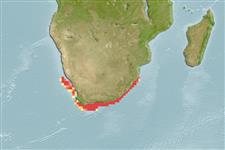Lớp phụ Cá sụn (cá mập và cá đuối) (sharks and rays) >
Carcharhiniformes (Ground sharks) >
Scyliorhinidae (Cat sharks) > Scyliorhininae
Etymology: Poroderma: poros (Gr.), hole or passage; derma (Gr.), skin or hide, allusion not explained nor evident (Smith proposed name without a description). (See ETYFish); pantherinum: Latin for leopard-like, referring to its variable leopard-like spots, stripes and blotches. (See ETYFish).
Environment: milieu / climate zone / depth range / distribution range
Sinh thái học
Biển Cùng sống ở rạn san hô; Mức độ sâu 0 - 256 m (Ref. 5578). Subtropical; 28°S - 36°S
Southeast Atlantic: Saldanha to central Natal, South Africa.
Bộ gần gũi / Khối lượng (Trọng lượng) / Age
Maturity: Lm ? range ? - ? cm
Max length : 84.0 cm TL con đực/không giới tính; (Ref. 244); 73.0 cm TL (female)
Short description
Hình thái học | Sinh trắc học
Các tia vây lưng cứng (tổng cộng): 0; Các vây lưng mềm (tổng cộng): 0; Tia cứng vây hậu môn 0; Tia mềm vây hậu môn: 0. A stocky shark with long nasal barbels and a highly variable color pattern of black spots, rings and lines in horizontal rows on a grey to whitish background; white below (Ref. 5578). There are 3 different forms, the typical 'pantherinum' with lines and rosettes of spots, and two extreme forms, 'marleyi' with large dark spots (formerly considered a separate species), and 'salt and pepper' with small, densely packed black spots, intermediates between these extremes are extremely common (Ref. 5578).
Found on or near the bottom of warm-temperate waters, from the intertidal zone to 256 m (Ref. 5578). Prefers rocky reefs (Ref. 5578). Nocturnal (Ref. 244). Feeds on small bony fish, crustaceans, octopus and polychaete worms (Ref. 5578). Oviparous (Ref. 50449). Readily kept in captivity (Ref. 244).
Life cycle and mating behavior
Chín muồi sinh dục | Sự tái sinh sản | Đẻ trứng | Các trứng | Sự sinh sản | Ấu trùng
Oviparous, produces one egg per oviduct (Ref. 5578). Embryos feed solely on yolk (Ref. 50449).
Compagno, L.J.V., D.A. Ebert and M.J. Smale, 1989. Guide to the sharks and rays of southern Africa. New Holland (Publ.) Ltd., London. 158 p. (Ref. 5578)
IUCN Red List Status (Ref. 130435)
Threat to humans
Harmless
Human uses
Các nghề cá: Các nghề cá là sinh kế; cá để chơi: đúng
Thêm thông tin
Age/SizeSự sinh trưởngLength-weightLength-lengthLength-frequenciesSinh trắc họcHình thái họcẤu trùngSự biến động ấu trùngBổ xungSự phong phúBRUVS
Các tài liệu tham khảoNuôi trồng thủy sảnTổng quan nuôi trồng thủy sảnCác giốngDi truyềnElectrophoresesDi sảnCác bệnhChế biếnNutrientsMass conversion
Các công cụ
Special reports
Download XML
Các nguồn internet
Estimates based on models
Preferred temperature (Ref.
123201): 12.4 - 22.1, mean 16.3 °C (based on 31 cells).
Phylogenetic diversity index (Ref.
82804): PD
50 = 0.7500 [Uniqueness, from 0.5 = low to 2.0 = high].
Bayesian length-weight: a=0.00263 (0.00139 - 0.00497), b=3.21 (3.04 - 3.38), in cm total length, based on LWR estimates for this (Sub)family-body shape (Ref.
93245).
Mức dinh dưỡng (Ref.
69278): 4.1 ±0.57 se; based on food items.
Thích nghi nhanh (Ref.
120179): thấp, thời gian nhân đôi của chủng quần tối thiểu là 4.5 - 14 năm (Fec assumed to be <100).
Fishing Vulnerability (Ref.
59153): Moderate to high vulnerability (54 of 100).
Nutrients (Ref.
124155): Calcium = 7.11 [1.51, 36.84] mg/100g; Iron = 0.352 [0.091, 1.024] mg/100g; Protein = 19.2 [16.2, 22.3] %; Omega3 = 0.125 [0.052, 0.290] g/100g; Selenium = 15.6 [4.5, 47.7] μg/100g; VitaminA = 36.5 [12.1, 119.9] μg/100g; Zinc = 0.539 [0.250, 1.132] mg/100g (wet weight);
